You can lay out floors, walls, and roofs using multiple spacings between the structural members. as long as the span and spacing meet the load requirements, you're free to choose. Generally, people choose numbers that add up to 48 inches and 96 inches because that's how big plywood is.
Whenever possible, draw a layout moving from right to left if you are right-handed or left to right if you are left-handed. This allows you to hold the tape tight with your left hand and mark with your right.
In this video, Tim uses a 24-inch layout for the floor, walls, and roof. The framing stacks above and below, which make it easier for mechanical trade contractors to run wires, pipes, and ducts without needing to cut (as many) structural parts.
And let's face it, we've all seen what plumbers do with sawzalls, so... you know, less is more sometimes.
Layout isn't just a bunch of hieroglyphics. It is an infographic.
If the subflooring is to break on the center of a floor joist, that floor joist must sit where its center will be exactly eight feet from the end of the building, where the subflooring will begin. Obviously.
To place a joist with its center at 96 inches, mark 95-1/4 inch for the line which defines the edge of the joist.
Of course, you'll need floor joists between the end of the building and the eight-foot mark. To properly place them, mark 3/4-inch before the two-foot marks on your tape measure: 23-1/4, 47-1/4, 59-1/4, 95-1/4. Keep laying out floor joists past the eight-foot mark until you either get to the end of the building or get to the end of your tape measure.
If you get to the end of the building, roll up your tape and stick it in your nail bags.
How to pull the layout without hooking your tape
If you get to the end of your tape, roll it up and stick the end on your last layout mark, holding the tape down about three inches away from the hook with your thumb. Hold the tape down with one thumb, and with the other hand, spread the tape, and hold the tape down tight with your finger. Now you can release the first finger and make the layout marks.
If you took the earlier advice about moving away from your dominant hand, you'd find this easy. If you didn't, you won't. Tim goes over this action at 4:45 in the video and says this:
Finger down; release. Finger down; release.
Every framer should be able to do that without losing accuracy
To carry the layout from the front and back walls to the midspan girders or pony walls, snap a line from front to back on the first layout mark. This gives a consistent starting point on all midspan supports that need layout lines.
Overlapping the floor joists shifts the layout 1-1/2 inches
Because the house is longer than most lumber, more than a single joist is needed to fill the length. A simple way to do this is to run joists next to each other. Breaking over a girder or bearing wall.
Lay out the opposite wall from that snapped line and make sure to mark the X on the correct side of the line (depending on whether the joist will sit in the original location or in its "sistered" location.
On plates where joists overlap, mark Xs on both sides of the line but at the edge of the plate that the joist extends toward.
Point loads can be accounted for after the basic layout is complete.
Cut and handle heavy joists efficiently
Make measuring faster: measure once cut six
With a deep saw, you can cut two joists at once, cutting the cutting in half. See what I did there? Flush the ends of multiple stacks of two joists—Tim does three. With six joists flushed at the end, measure the length, use a large speed square to mark across the face of the three pairs of joists, and cut them all with a deep saw.
One measurement, three cuts, and six joists.
Order joists long enough to account for blocks
It may cost slightly more to buy joists that are two feet longer than you need them, but if you can cut two parts from it, you'll only have to lift one big piece of lumber for two parts. Measure the joist from the right and measure the block from the left. Two cuts, two parts, and a piece of firewood.
Never carry the full weight if you don’t need to
There will be plenty of times that you need to carry big lumber by yourself, so forget about FOMO; use leverage whenever possible. It’ll speed up your workflow and reduce strain on your body, which does not get younger. Tim notes that people who work in lumberyards get very good at this, so watch them work when you’re at the lumberyard.
Stack the floor like you've been there before
Lay joists across their spans, leaning on the bearing wall or beam and the mudsill. Slide one end of each joist out the previous one to the beam at the end and then roll the joist into place. Lay them with all crowns facing the same way.
Tim crowns then right now, when he's wrestled it into place, rather than when he's at the lumber pile because he just doesn't trust himself not to screw it up between the lumber pile and the house.
When stacking the joists on the foundation, crown them all to the same side.
Before even picking them up, though, roll the joist and whack it to knock the sawdust off. Sawdust is slippery and should be knocked off lumber whenever it is an easy part of the workflow.
Install the rim joist
When the joists are spread, crowned, and properly stacked, install the rim along the mud sill. Because the mud sill is perfectly straight (because Tim is a conscientious framer), the rim can be toenailed flush with the outside edge. Toenailing with 8d common nails will reduce the chances of splitting the rim.
If the rim has little to no crown, crown the rim up. If the rim has a more pronounced crown, crown it down, and pull it straight. Fasten one end with a structural framing screw, from below.
In this case, the rim is atop a pony wall, so time screws up through the top plates into the rim. If the mudsill is sitting on a foundation wall, you'll have to angle up through the mudsill into the rim.
Now, the opposite end is pretty high up in the air, so suck the opposite end down with another structural screw, from below.
Roll the joists, put them on the line, and nail them
With the rim joist installed along one end of the foundation, you can roll the joists into place and face-nail them through the rim joist. Tim says that he's gotten some guff about moving backward, but working backward allows you to stand on the flat face of the joist, so it provides a safer work platform than working forward.
It also lowers the amount of bending over you'll do over the course of the floor because if you are standing atop the floor framing, you've put yourself a foot farther from the work.
Put the joist on the line and nail the bottom. Straighten the joist to the layout line and nail it off. Toenail the joist with two nails into the mud sill on each side.
Toenail the opposite end of the joists into the beam or bearing wall below, but don’t toenail where the pressure blocks will go because, well, the nails will be in the way.
Blocking is boring, so don't spend more time on it than you need to
In some zones, such as seismic zones, the requirement is to add blocking over all intermediate posts, beams, or supports. That's not the case everywhere.
For blocking between joists, cut the blocks slightly shorter than the space between because—framing always grows. It just does.
Because there are 22-1/2 inches between joists on a 24-inch o.c layout, cut all of the blocks to 22-7/16-inch.
When staging the blocks, lean them in the opposite direction that you are working. Leaning away from you will eliminate a lot of head whacks, dropped blocks, and colorful language.
Nail the blocks and then toenail the joists to the beam, paying attention to the layout as you work from one end to the other. If joists are growing off the layout, cut a shorter block and get back to the layout.











